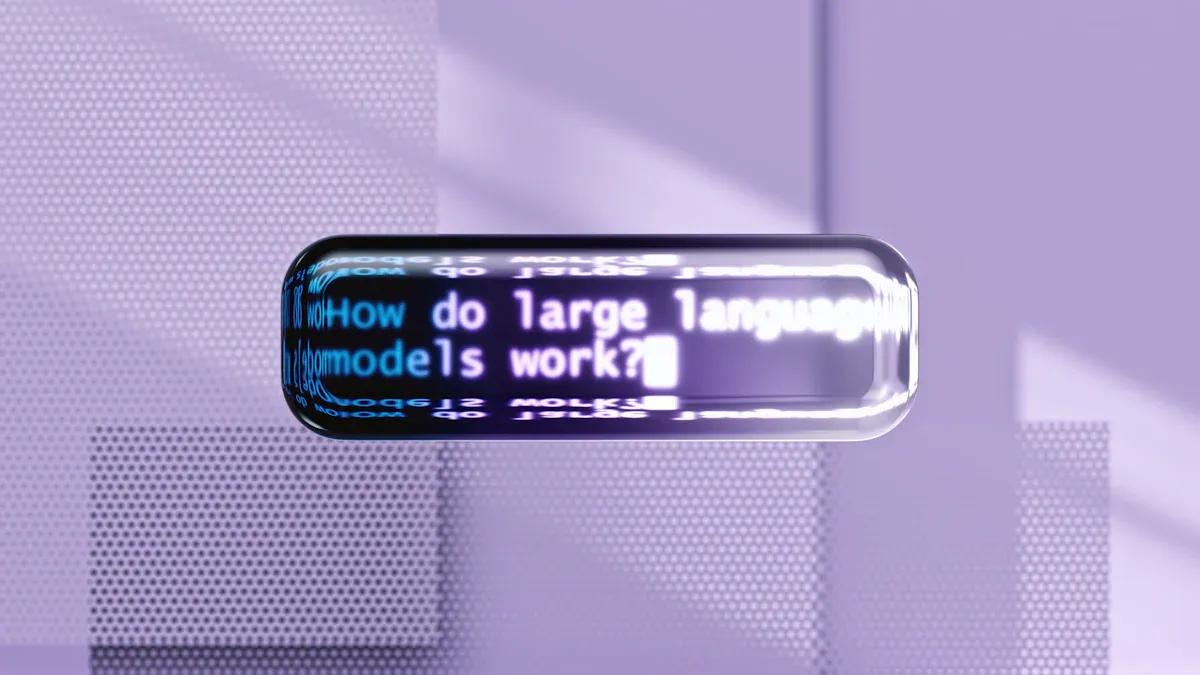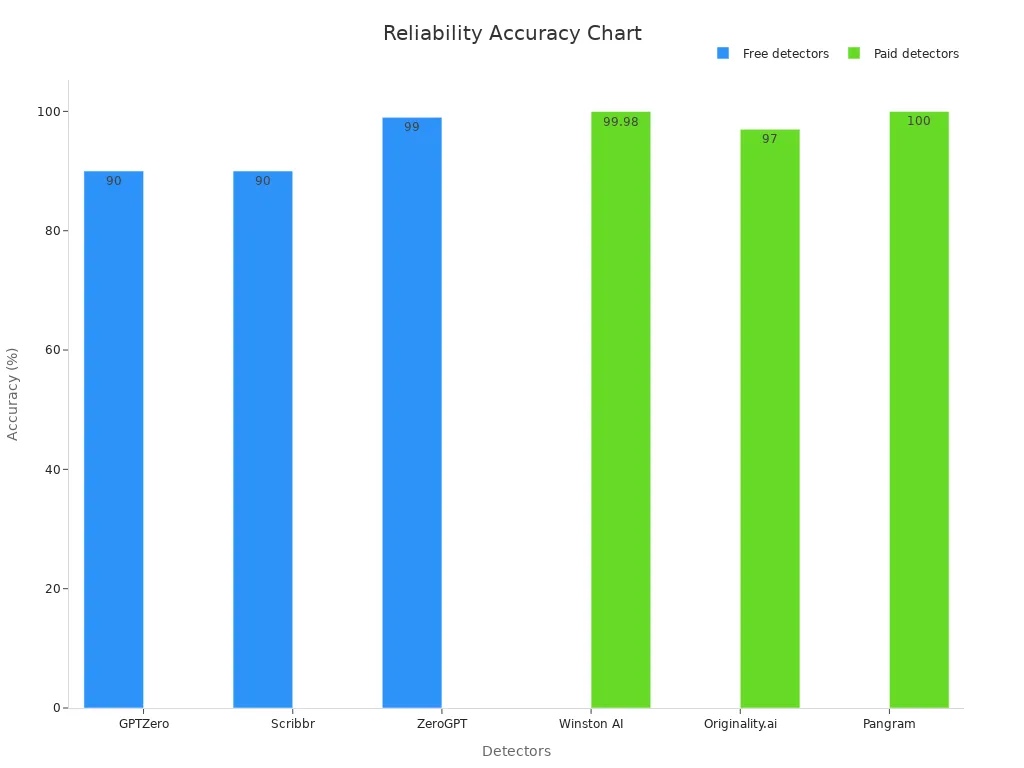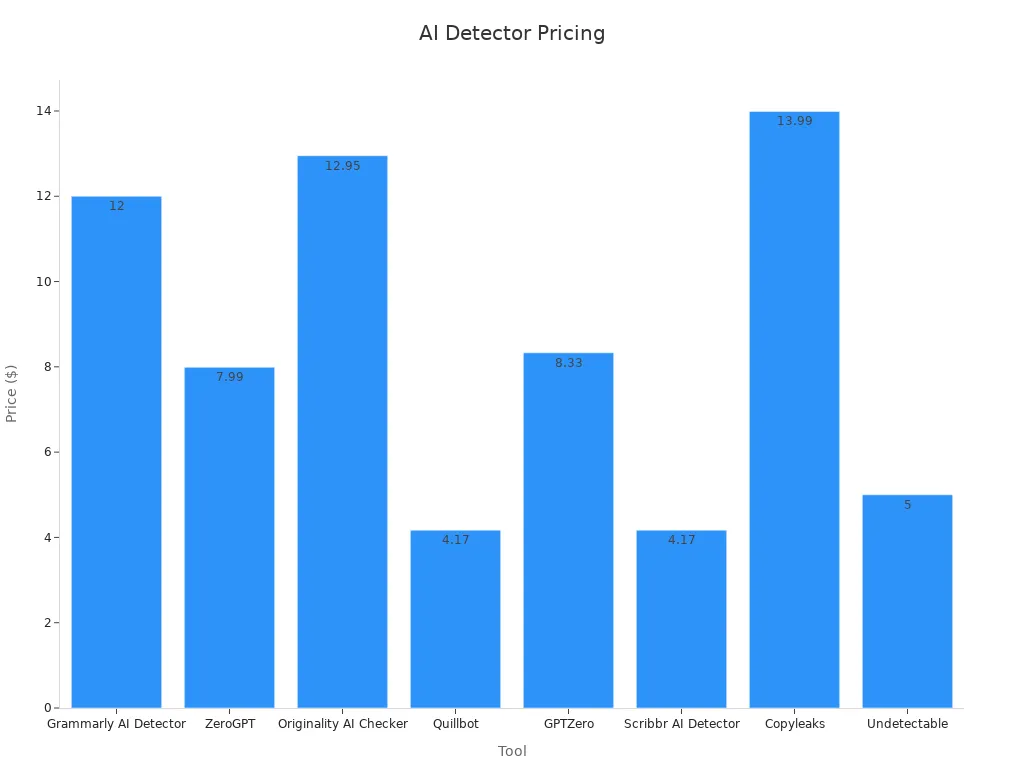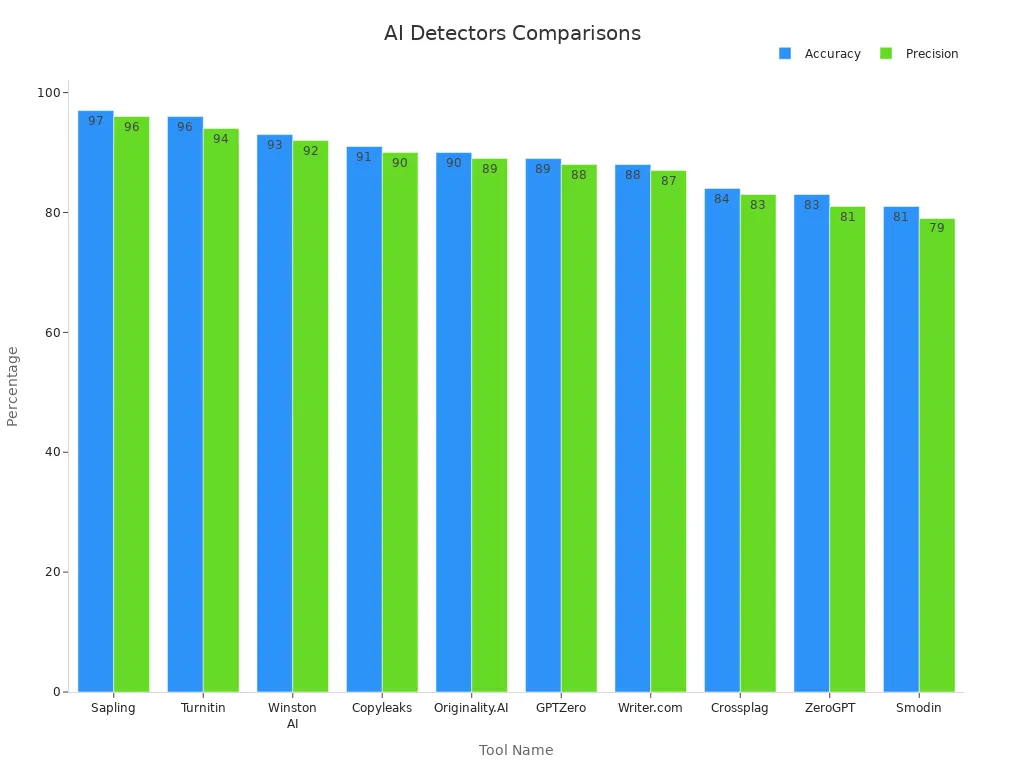
AI writing detector tools such as AI Detector, Grammarly, Originality.AI, GPTZero, Winston AI, Pangram Labs, and Smodin lead the field in 2025. These ai content detectors use advanced metrics like accuracy, precision, and F1-score, ensuring reliable detection of ai-generated content. Users should match writing needs with the right detection tools.
Key Takeaways
-
AI writing detectors help identify AI-generated content to support academic honesty and professional writing quality, with top tools offering high accuracy and real-time feedback.
-
Choosing the right AI detector depends on your specific needs, such as academic use, real-time detection, or free access, while considering accuracy, features, and integration with your workflow.
-
Use AI detectors as part of a broader review process to verify content authenticity, avoid over-reliance, and maintain ethical writing practices in both education and professional settings.
Top AI Content Detectors

The landscape of ai content detectors in 2025 features a diverse range of tools designed for different writing needs. These tools help users distinguish between human and ai-generated content, supporting academic integrity and professional standards.
Best Overall AI Detector
AI Detector stands out as the best ai writing detector for most users. Evaluators ranked it highest based on accuracy in identifying ai-generated content across a wide range of real-world writing scenarios. The assessment included basic outputs from ChatGPT, rewritten texts, and human-edited samples. The tool consistently delivered high accuracy, even when writers attempted to evade detection. While pricing and extra features matter, accuracy remains the top priority for those seeking reliable ai content detectors.
Best for Academic Use
Originality.AI and Winston AI lead among ai content detectors for academic writing. These tools offer high accuracy and robust features for verifying student work. Academic institutions recommend the following best practices:
-
Use research-backed ai detection tool options.
-
Interpret detection scores with care.
-
Discuss writing processes with students.
-
Review drafts and version histories.
-
Treat detection as a prompt for further review, not as final proof.
-
Look for repeated detection results and corroborate with context.
However, some universities have stopped using ai content detectors due to concerns about false positives and bias, especially for non-native English speakers. Simple paraphrasing can also reduce detection accuracy, so educators should use these tools as part of a broader review process.
Best Free AI Detector
Free ai content detectors like GPTZero, ZeroGPT, and Scribbr provide accessible options for quick checks. These tools offer decent accuracy, but paid versions such as Originality.AI and Pangram Labs deliver higher accuracy and advanced features. The following table compares popular detectors:
|
Detector |
Type |
Accuracy |
Key Features |
|---|---|---|---|
|
GPTZero |
Free |
User-friendly, detailed analysis |
|
|
ZeroGPT |
Free |
~99% |
Confidence scores, API access |
|
Originality.ai |
Paid |
Advanced features, adversarial data |
|
|
Pangram |
Paid |
Minimal false positives/negatives |

Best for Real-Time Detection
For real-time analysis, tools like Pangram Labs and Winston AI excel. These ai content detectors provide instant feedback on writing, making them ideal for high-volume environments. Real-time analysis relies on monitoring latency, throughput, and error rates to ensure high accuracy. Optimization techniques such as data parallelism and distributed processing help these tools deliver timely and precise detection of ai-generated content. Real-time analysis supports both academic and professional workflows, allowing users to maintain writing standards as content is created.
Why Use an AI Writing Detector
Academic Integrity
Academic institutions face increasing challenges in maintaining content authenticity and writing quality. Studies show that academic misconduct remains widespread, with some research reporting cheating rates as high as 90%. The rise of ai-generated content complicates assessments and makes traditional plagiarism detection less effective. Educators now rely on ai writing detector tools to distinguish between human and machine-generated writing. These tools support content verification and help uphold academic standards.
AI systems like ChatGPT often produce hallucinated or false information. Educators must spend extra time on content verification and plagiarism checks to ensure accuracy. AI-generated content can also introduce bias, reinforce dominant language norms, and marginalize non-standard English dialects. Privacy concerns arise because AI platforms store user data without clear regulation, making content authenticity and ethical writing practices even more important.
Institutions combine detection tools with strong policies and educational programs. They encourage students to develop original writing skills and use ai writing detector results as part of a broader review process. This approach helps maintain content quality and supports academic honesty.
Professional Compliance
Businesses and organizations must protect content authenticity and meet regulatory standards. The rapid adoption of generative AI in the workplace introduces risks such as security flaws, privacy issues, and inaccurate outputs. Compliance teams use ai writing detector solutions for content verification and plagiarism detection to avoid operational and legal liabilities.
Industry analysis highlights the need for oversight as employees use AI tools for writing tasks. Shadow AI—unofficial use of AI—can lead to data leakage and undermine content quality. Regulatory frameworks like the EU AI Act require companies to monitor ai-generated content and ensure proper content verification.
Professional environments depend on detection tools to maintain writing quality, support plagiarism checks, and verify content authenticity. These measures help organizations build trust and protect sensitive information.
In-Depth Reviews of Best AI Detectors
AI Detector
AI Detector leads the market as a comprehensive ai detection tool for both academic and professional environments. This tool uses advanced algorithms to identify ai-generated content with high accuracy. Companies like Netflix and LinkedIn rely on AI Detector for continuous monitoring, using drift detection and anomaly alerts to maintain consistent performance. UptimeRobot’s integration ensures reliable operation and instant alerts for any issues.
Key Features:
-
Real-time ai-generated content detection
-
Advanced model monitoring and drift detection
-
Customizable detailed reports for writing analysis
-
Integration with major workflow platforms
Performance Metrics and User Feedback:
-
AI-powered call scoring tracks average handle time, first call resolution, and customer satisfaction.
-
Personalized coaching programs improve writing skills.
-
Contextualized feedback increases acceptance and effectiveness.
-
Self-service learning portals and gamification boost engagement.
|
Metric |
Description & Use Case |
How It Supports AI Detector Effectiveness |
|---|---|---|
|
Measures efficiency of customer support interactions. |
Lower times indicate faster issue resolution, showing AI's impact. |
|
|
First Call Resolution |
Tracks percentage of issues resolved on first contact. |
High rates correlate with better AI detection and problem solving. |
|
Customer Satisfaction |
Scores reflecting user happiness with support. |
Higher scores indicate AI is improving user experience. |
|
First Response Time |
Time taken to respond to customer inquiries. |
Faster responses demonstrate AI's ability to promptly detect and act. |
|
Customer Effort Score |
Measures ease of customer interaction with service/product. |
Lower effort scores suggest AI reduces friction in user interactions. |
|
User Feedback Mechanisms |
Includes surveys, NPS, in-app ratings to gather qualitative user opinions. |
Provides direct user validation of AI Detector's effectiveness. |
Pros:
-
High accuracy in detecting ai-generated content
-
Actionable detailed reports
-
Strong integration with business workflows
Cons:
-
Advanced features may require training
-
Pricing can be higher for enterprise plans
Pricing:
Custom pricing based on usage and features.
Best Use Cases:
Academic institutions, enterprise customer support, compliance teams, and organizations needing continuous writing quality monitoring.
Grammarly
Grammarly stands out as a popular ai detection tool, especially for users who value grammar checking and writing enhancement. The platform supports detection of ai-generated content from tools like ChatGPT, Google Gemini, and Claude. Grammarly’s AI detector provides transparency by categorizing text as AI-generated, online-sourced, or user-typed, and it offers clear ‘AI use' citations.
Key Features:
-
Real-time grammar checking and writing suggestions
-
AI-generated content detection with high accuracy
-
Free usage up to 10,000 characters
-
API support for large-scale projects
-
Detailed reports on writing quality
|
AI Detector Tool |
Accuracy Level |
Free Usage Limit |
API Support |
Monthly Price |
|---|---|---|---|---|
|
High |
Up to 10,000 characters |
Yes |
$12 |
|
|
ZeroGPT |
High |
Up to 15,000 characters |
Yes |
$7.99 |
|
Originality AI Checker |
High |
No |
Yes |
$12.95 |
|
Quillbot |
High |
Up to 1200 words |
No |
$4.17 |
|
GPTZero |
High |
Up to 5000 characters |
Yes |
$8.33 |
|
Scribbr AI Detector |
High |
Up to 1200 words |
No |
$4.17 |
|
Copyleaks |
High |
Yes |
Yes |
$13.99 |
|
Undetectable |
High |
Yes |
Yes |
$5 |
|
Writer.com AI detector |
Low |
Up to 1200 words |
Yes |
N/A |

-
Human-written texts: 0% AI content detected
-
GPT-4-turbo generated text: 46% AI patterns detected when logged in (30% if not logged in)
-
GPT-4.5 generated text: 96% AI patterns detected (consistent regardless of login status)
Pros:
-
High accuracy in grammar checking and ai-generated content detection
-
User-friendly interface
-
Free tier available
Cons:
-
Only supports English
-
Some advanced features require a paid plan
Pricing:
Free for up to 10,000 characters; Pro plan starts at $12/month.
Best Use Cases:
Academic writing, business communication, and professional editing where grammar and ai-generated content detection are essential.
Originality.AI
Originality.AI is a trusted ai detection tool for academic and professional environments. It delivers high accuracy in identifying ai-generated content, even in paraphrased or edited texts. The tool offers detailed reports that help educators and compliance officers verify writing authenticity.
Key Features:
-
High accuracy in detecting ai-generated content
-
Plagiarism detection and grammar checking
-
Bulk scanning for large documents
-
API access for workflow integration
Pros:
-
Reliable for academic integrity checks
-
Comprehensive detailed reports
-
Supports large-scale document analysis
Cons:
-
No free plan
-
Interface may feel technical for beginners
Pricing:
Starts at $12.95/month.
Best Use Cases:
Universities, research institutions, and businesses requiring robust ai content detectors for writing verification.
GPTZero
GPTZero has become a go-to ai detection tool for educators and professionals seeking quick, free checks of ai-generated content. The tool provides high accuracy and user-friendly grammar checking, making it accessible for a wide audience.
Key Features:
-
Free ai-generated content detection up to 5,000 characters
-
Simple grammar checking and writing analysis
-
Confidence scores and detailed reports
-
API support for integration
Pros:
-
High accuracy for a free tool
-
Fast and easy to use
-
Offers detailed reports for writing review
Cons:
-
Limited to shorter texts in the free version
-
Fewer advanced features than paid competitors
Pricing:
Free for up to 5,000 characters; paid plans start at $8.33/month.
Best Use Cases:
Teachers, students, and professionals needing quick checks of writing for ai-generated content.
Winston AI
Winston AI specializes in real-time ai-generated content detection for academic and professional writing. The tool delivers high accuracy and supports detailed reports, making it a strong choice for institutions and businesses.
Key Features:
-
Real-time ai content detectors for instant feedback
-
High accuracy in grammar checking and writing analysis
-
Plagiarism detection included
-
Customizable reports for compliance
Pros:
-
Fast, real-time detection
-
Comprehensive grammar checking
-
Detailed reports for academic and business use
Cons:
-
Premium pricing for advanced features
-
May require onboarding for full functionality
Pricing:
Custom pricing based on organization size and needs.
Best Use Cases:
Academic institutions, compliance teams, and organizations with high writing volume.
Pangram Labs
Pangram Labs offers a powerful ai detection tool focused on real-time analysis and minimal false positives. The tool excels in environments where high accuracy and speed are critical. Pangram Labs supports detailed reports and integrates with existing writing workflows.
Key Features:
-
Real-time ai-generated content detection
-
High accuracy with minimal errors
-
Detailed reports for writing quality
-
API and workflow integration
Pros:
-
Near-perfect ai detection accuracy
-
Fast, scalable for large organizations
-
Actionable reports for compliance
Cons:
-
Higher cost for enterprise features
-
May be overkill for small teams
Pricing:
Enterprise pricing; contact for details.
Best Use Cases:
Large businesses, publishers, and academic institutions needing instant, reliable ai content detectors.
Smodin
Smodin stands out as a versatile ai writing detector and assistant, designed for academic and professional writing. The tool supports grammar checking, text generation, rephrasing, and summarization. Smodin’s specialized AI solvers help with subject-specific tasks in fields like math, history, and accounting.
Customer reviews highlight Smodin’s reliability for literature reviews and research papers. The platform offers a user-friendly interface, multilingual support, and continuous feature updates. Free trials and affordable plans make it accessible for students and professionals.
|
Feature/Aspect |
Jasper AI |
|
|---|---|---|
|
Pricing |
Free plan available; paid plans from $12/month to $63/month; no hidden fees; affordable for students |
No free plan; 7-day trial requires credit card; plans start at $39/month; some features locked in lower tiers |
|
Academic Suitability |
Designed for academic use; supports niche topics; includes plagiarism checker, rewriter, summarizer, and specialized solvers |
Better for marketing and general content; struggles with niche academic topics; plagiarism checker is paid and costly for long content |
|
Multilingual Support |
Supports over 100 languages; writes like a native speaker; strong NLP capabilities |
Limited multilingual support; primarily English-focused |
|
User Interface |
User-friendly, intuitive, easy for beginners; accessible tools with help text |
More complex; geared towards marketing professionals |
|
Feature Set |
Comprehensive academic tools including AI question solver, accounting solver, plagiarism checker, rewriter |
Focused on marketing content generation, image generation, and brand voice |
|
Reliability |
Generates natural, human-like text; reduces creative blocks; positive user reviews in academic settings |
Good for short-form marketing content; less reliable for academic research |
|
Additional Benefits |
Affiliate program for students; continuous feature updates |
No affiliate program mentioned |
Smodin’s grammar checking and detailed reports help users improve writing quality and ensure content authenticity.
Pros:
-
Comprehensive academic and professional writing tools
-
High accuracy in grammar checking and ai-generated content detection
-
Affordable and accessible for students
Cons:
-
Some advanced features require a paid plan
-
Occasional delays during peak usage
Pricing:
Free plan available; paid plans from $12/month.
Best Use Cases:
Students, educators, and professionals seeking reliable ai content detectors and writing enhancement tools.
AI Writing Detector Comparison Table

Feature Overview
Selecting the right AI writing detector depends on understanding how each tool performs in real-world scenarios. The following table compares leading tools based on accuracy, precision, detection speed, pricing, and their primary use cases. This overview helps users evaluate which solution best supports content authenticity, content verification, and writing needs.
|
Tool Name |
Accuracy |
Precision |
False Positive Rate |
Detection Speed |
Pricing Model |
Key Features and Target Users |
|---|---|---|---|---|---|---|
|
Sapling |
97% |
96% |
Low |
Fast |
Free & Paid Plans |
High-precision AI detection, grammar enhancement; accuracy-focused users |
|
Turnitin |
96% |
94% |
Very Low |
Slow |
Institutional Pricing |
Academic AI detection, plagiarism detection; universities |
|
Winston AI |
93% |
92% |
Very Low |
Medium |
Free & Paid Plans |
Education platform integrations, plagiarism detection; educators |
|
Copyleaks |
91% |
90% |
Low |
Slow |
Custom Pricing |
Large file support, API integration; enterprises, universities |
|
Originality.AI |
90% |
89% |
Low |
Fast |
Pay-per-credit ($0.01) |
AI and plagiarism detection, team collaboration; publishers |
|
GPTZero |
89% |
88% |
Moderate |
Medium |
Free & Paid Plans |
Sentence-level AI analysis; writers, content analysts |
|
Writer.com |
88% |
87% |
Moderate |
Fast |
Custom Pricing |
Enterprise-grade detection, compliance; large teams |
|
Crossplag |
84% |
83% |
Moderate |
Fast |
Freemium |
AI and plagiarism detection; educational institutions |
|
ZeroGPT |
83% |
81% |
High |
Very Fast |
Free |
Minimal UI, instant results; budget users |
|
Smodin |
81% |
79% |
High |
Very Fast |
Free & Paid Plans |
Lightweight AI checker, plagiarism scan; students |

These tools offer a range of features, from grammar checking to comprehensive reports. Some focus on content verification for academic writing, while others prioritize speed or affordability. Users should consider how each tool supports content authenticity and content quality in their workflow.
Strengths and Limitations
AI writing detectors show unique strengths and limitations when tested side by side.
-
Sapling and Turnitin deliver high accuracy and low false positives, making them reliable for content verification and plagiarism detection in academic settings.
-
Winston AI and Copyleaks integrate well with education platforms and support large files, but slower detection may impact urgent writing tasks.
-
Originality.AI and GPTZero provide fast detection and detailed reports, supporting content authenticity and quick content verification for publishers and analysts.
-
ZeroGPT and Smodin offer very fast results and free access, but higher false positive rates can affect content quality and trust in reports.
-
Writer.com and Crossplag target enterprise and educational users, balancing detection speed and comprehensive reports for large teams.
Experts recommend evaluating each tool’s performance using real-world writing samples. Live demonstrations and prompt-by-prompt comparisons reveal how tools handle content verification, plagiarism detection, and content authenticity in practice. Users should review detailed reports and comprehensive reports to identify which solution best maintains writing standards.
Choosing the Best AI Writing Assistants
Selection Tips
Selecting the best ai writing assistants requires careful evaluation of features and user needs. Experts recommend prioritizing tools that offer grammar checking, plagiarism detection, and multi-language support. Industry best practices highlight the importance of SEO optimization, user-friendly interfaces, and the ability to refine and edit AI-generated content. Users should look for assistants that support content authenticity and allow for easy customization. Comparative studies show that top-ranked assistants excel in long-form writing, text personalization, and collaboration. Reviewing user feedback on reliability and productivity can help identify the right ai writing assistant for specific writing tasks.
Workflow Integration
Seamless workflow integration boosts writing efficiency and reduces stress. Paperpal, for example, supports every stage of the writing process and connects with platforms like MS Word, Overleaf, and Google Docs. This integration allows users to check grammar, manage citations, and generate content without switching tools. Other assistants, such as ThesisAI and Writefull, provide real-time feedback and support multiple formats, making them suitable for academic and professional environments. Research shows that AI automates repetitive writing tasks, improves team morale, and enhances collaboration. Choosing assistants that fit existing workflows ensures consistent writing quality.
Avoiding Pitfalls
Users should remain aware of common pitfalls when adopting ai writing assistants. Over-reliance on AI can lead to reduced originality and missed errors in grammar or content. Experts advise using assistants as supportive tools, not replacements for human authorship. Regularly verifying information, maintaining authorship, and refining AI-generated writing help preserve content quality. Strategic implementation, ongoing upskilling, and ethical guidelines further reduce risks and maximize the benefits of these assistants.
Best AI Detectors: Summary and Recommendations
Top Picks Recap
Selecting the right AI writing detector depends on accuracy, integration, and use case. The following table summarizes leading solutions, their strengths, and ideal applications:
|
AI Detector Name |
Key Strengths |
Limitations |
Best Use Cases |
Pricing Range |
|---|---|---|---|---|
|
OpenAI Detector |
High accuracy, real-time analysis |
Premium pricing, subscription needed |
Publishers, marketers, academic institutions |
~$49/month |
|
Copyleaks AI Detector |
Dual detection, detailed reports |
Premium pricing for high volume |
Educational institutions, media organizations |
~$39/month |
|
Grammarly Business |
All-in-one writing tool with AI detection |
AI detection is secondary feature |
Businesses, content creators |
~$12/month per user |
|
Originality.AI |
Specialized AI & plagiarism detection |
Premium pricing |
Publishers, agencies, academic journals |
~$49/month |
|
Sapling AI Detector |
High accuracy, user-friendly interface |
Limited free version |
Large enterprises, academic institutions |
~$25/month |
|
Content at Scale Detector |
Fast batch processing, customizable thresholds |
Premium pricing, learning curve |
Large publishers, marketing agencies |
~$44/month |
|
GLTR |
Innovative visual approach, free |
Technical interface, research-focused |
Academic researchers, publishers |
Free |
|
Writer.com AI Detector |
Seamless integration, customizable |
Premium pricing, integration setup |
Businesses, content teams |
~$45/month |
|
AI Detector Pro |
Enterprise-grade detection, comprehensive reporting |
High cost, advanced setup needed |
Large enterprises, digital publishers |
~$59/month |
A digital publishing house using OpenAI Detector and Copyleaks reduced AI-generated low-quality content by 45%. An academic institution employing Copyleaks AI Detector decreased AI-generated plagiarism by 30%. Experts recommend combining multiple tools and monitoring authenticity scores for the best results.
Next Steps
To adopt the best ai detectors efficiently, organizations can follow a phased approach:
-
Foundation Phase (Days 1-7): Register for essential AI tools, set baseline metrics, and train team members.
-
Integration Phase (Days 8-14): Connect AI tools to existing systems, automate workflows, and establish security protocols.
-
Optimization Phase (Days 15-21): Apply advanced strategies, add specialized tools, and automate reporting.
-
Scale & Measure Phase (Days 22-30): Expand deployment, develop department workflows, and analyze performance.
Track metrics such as time saved and content quality improvements. Choose tools that align with business needs and technical skills. A structured roadmap ensures measurable results and smooth integration.
Top AI writing detectors like Word Spinner and Grok AI deliver standout features, including advanced templates and superior reasoning modes. Users in academic and professional fields benefit from improved accuracy and satisfaction. Selecting the right tool ensures effective detection. For deeper insights, explore statistical methods and user-friendly platforms that support ongoing learning.
FAQ
How accurate are AI writing detectors in 2025?
Most leading AI detectors achieve over 90% accuracy. Results may vary based on text complexity and the specific tool used.
Can AI detectors identify paraphrased or edited AI content?
AI detectors often flag paraphrased or lightly edited AI text. However, heavy rewriting can reduce detection accuracy.
Are AI writing detectors safe for sensitive or private documents?
-
Many tools use secure servers.
-
Users should review privacy policies before uploading confidential information.
-
Enterprise plans usually offer enhanced data protection.








